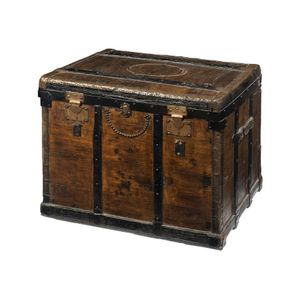Antique Writing Slope with Tunbridgeware Trims
You must be a subscriber, and be logged in to view price and dealer details.
Subscribe Now to view actual auction price for this item
When you subscribe, you have the option of setting the currency in which to display prices to $Au, $US, $NZ or Stg.
- Cartouche - An ornamental panel in the form of of a shield, oval or rectangular scroll with curling edges. It may be carved into the back of a chair or the top of a sideboard, or present on a piece of silver or jewellery, and contain the initials of the original owner, heraldic symbols, or some other inscription, such as the details of a presentation.
In ceramics the term defines the central area of a vase or similar with a decorative border in one of the shapes above, into which a decorative scene or figures have been painted. - Burr - Burr (or in the USA, burl) is the timber from the knotted roots or deformed branch of the tree, which when cut, displays the small circular knots in various gradations of colour. It is always cut into a decorative veneer, most commonly seen as burr walnut on 19th century furniture.
- Baize - Baize is a type of fabric that is made from wool or a wool blend. It is a dense, closely-woven fabric that is smooth to the touch and has a matte finish. Baize is often used for covering surfaces, such as table tops or the playing surface of card, pool and billiard tables, and for lining drawers and boxes, because it is durable and resistant to wear. This fabric is often associated with gambling and is often used on casino gaming tables and other gaming equipment.
- Mother-Of-Pearl - Mother-of-pearl, technical name "nacre", is the inner layer of a sea shell. The iridescent colours and strength of this material were widely used in the nineteenth century as an inlay in jewellery, furniture, (especially papier mache furniture) and musical instruments.
In the early 1900s it was used to make pearl buttons. Mother-of-pearl is a soft material that is easily cut or engraved.
Nowadays it is a by-product of the oyster, freshwater pearl mussel and abalone industries.
This item has been included into following indexes:
Visually similar items

A brass and metal mounted travelling trunk, French, early 19th century, stamped D.Jne_Brevete 8.G.D.G, 64 cm high, 76 cm wide, 52 cm deep

An unusual Tibetan wooden dowry box, applied repousse silver trimmings, top and sides mounted with Garuda and flames motif, interior decorated with painted mandala and inset with a coral and a turquoise, painting faded, 35.5 x, 22 x 20 cm

A Victorian rosewood writing box, 19th century, the rectangular box with a mother-of-pearl cartouche to the lid and a matching escutcheon, with white metal stringing to the edges and mother-of-pearl eyelet motifs. Height 12.5 cm. Width 30 cm. Depth 21.5 cm

Walnut stationary box, brass crest to top, no key, approx 18 cm high, 32 cm wide, 23 cm deep
